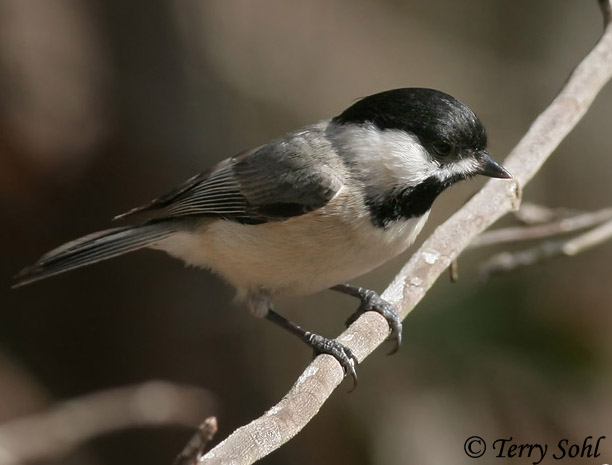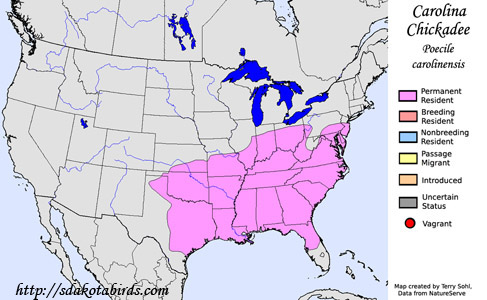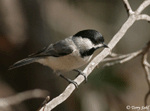Carolina Chickadee
Poecile carolinensis
| Length: 4.75 inches | Wingspan: 7.5 inches | Seasonality: Non-resident in South Dakota |
| ID Keys: Black cap and throat, white face, grayish upperparts, dusky white below | ||
 The
Carolina Chickadee is very similar to the
Black-capped Chickadee. The
Carolina Chickadee is smaller and has a shorter tail than the Black-capped
Chickadee, but the primary distinguishing characteristic is geographic
range. The Carolina Chickadee is found throughout most of the
southeastern United States, while the Black-capped Chickadee is found
further north. In the area where their ranges overlap, the two species
may sometimes interbreed.
The
Carolina Chickadee is very similar to the
Black-capped Chickadee. The
Carolina Chickadee is smaller and has a shorter tail than the Black-capped
Chickadee, but the primary distinguishing characteristic is geographic
range. The Carolina Chickadee is found throughout most of the
southeastern United States, while the Black-capped Chickadee is found
further north. In the area where their ranges overlap, the two species
may sometimes interbreed.
Habitat: Found in deciduous forests and woodlands, or mixed forest habitats. They have adapted well to a human presence and will also often be found in heavily treed suburban areas.
Diet: Feeds on insects, fruits, berries, seeds, and nuts. The summer diet consists mostly of insects and spiders, while the winter diet may be mostly vegetative material.
Behavior: Forages by moving quickly through the branches and foliage of trees, clambering or making short flights ass it searches for insects and other food items. They may sometimes fly out and capture insects in mid-air, or hover while gleaning insects from foliage.
Nesting: The nest of a Carolina Chickadee is built in a cavity in a tree, lined with strips of bark or plant down. They have also learned to use artificial nest boxes. The female lays between 5 and 7 eggs, and the female alone incubates them. When the eggs hatch, both parents help to feed the young. The young leave the nest after about 2 weeks.
Song: The song of a Carolina Chickadee is a series of three to five singles notes, each with a different pitch.
Migration: Considered a permanent resident throughout its normal range.
Interactive eBird Map: Click for access to an interactive eBird map of Carolina Chickadee sightings
Similar Species: Black-capped Chickadee
Feeders: Will attend feeders for suet, peanut butter, and various nuts.
Conservation Status: Carolina Chickadees are common in many parts of their range, populations are stable, and they are found over a wide geographic area. The IUCN lists the Carolina Chickadee as a species of "Least Concern".
Further Information: 1) WhatBird - Carolina Chickadee
2) Ohio Department of Natural Resources - Carolina Chickadee
3) Audubon Guide - Carolina Chickadee
Photo Information: Photo taken on February 12th, 2008 - Bon Secour National Wildlife Refuge, Alabama - Terry Sohl
| Click below for a higher-resolution map |
 |
| South Dakota Status: Non-resident in South Dakota |
Additional Carolina Chickadee Photos
Click for a higher-resolution version of these photos

